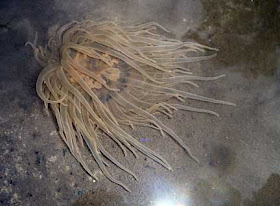 The Army gets to sleep in today as we start work AFTER daybreak for a change.
The Army gets to sleep in today as we start work AFTER daybreak for a change.It's not easy working in deep squishy mud. But June seems happy as she poses for a photograph. While Dr Daphne, as usual, is way ahead, setting the pace for the rest of us.
 Martyn is amazing and is already way out in the distance (see his red bucket?), hard at work, as I struggle to stay upright. On the horizon is Johor.
Martyn is amazing and is already way out in the distance (see his red bucket?), hard at work, as I struggle to stay upright. On the horizon is Johor. Today, we are tasked with finding this anemone which is quite abundant in mangroves. I've also seen them in silty shores and shores near mangroves.
Today, we are tasked with finding this anemone which is quite abundant in mangroves. I've also seen them in silty shores and shores near mangroves. The anemone has petal-shaped structures around the mouth. Dr Daphne thinks there might be two or even more different kinds of these anemones. She really needs to take a closer look at them to be sure.
The anemone has petal-shaped structures around the mouth. Dr Daphne thinks there might be two or even more different kinds of these anemones. She really needs to take a closer look at them to be sure. Dr Daphne also finds some intriguing nems stuck in rotting dead wood in the mangroves. Wow! I can't wait to find out more about the anemones found in our mangroves.
Dr Daphne also finds some intriguing nems stuck in rotting dead wood in the mangroves. Wow! I can't wait to find out more about the anemones found in our mangroves.James took some great shots of these anemones back in the lab! More on his blog.
By the time we are done, we are covered in mud. I didn't take many photos because after a while I couldn't find a mud-free spot on my shirt to wipe the sneaky cam free of mud.
 As usual, we find ways to clean up in even the shallowest streams.
As usual, we find ways to clean up in even the shallowest streams. With a more thorough scrub in more civilised settings. It helps to have a friend keep the push tap down but this often results in really odd photos.
With a more thorough scrub in more civilised settings. It helps to have a friend keep the push tap down but this often results in really odd photos. Andrea would like a group photo of the intrepid Army. And we decide the best background would be between the Handicapped toilet and Diaper Change area.
Andrea would like a group photo of the intrepid Army. And we decide the best background would be between the Handicapped toilet and Diaper Change area. You have to be wild and wacky to be part of the Anemone Army!
You have to be wild and wacky to be part of the Anemone Army!It's been a gruelling EIGHT days of field trips! But I really enjoyed the company. Indeed as Andrea commented, field work does bond people together. I learnt so much from Dr Daphne, not just about anemones. But also about conservation issues and life in general. And her enthusiasm for our marine life is highly infectious! I am quite inspired to continue to monitor our shores for sea anemones.
While the Hunt has ended with the tides, there's still a lot more work ahead for Dr Daphne and Andrea and the hardworking folks at the Raffles Museum of Biodiversity Research. What will they discover about our anemones? I can't wait to find out!
Other posts about this trip
- Sungei Buloh - The last leg by James on his Singapore Nature blog.
- Back to Buloh for nem hunt by Kok Sheng on his wonderful creation blog.
